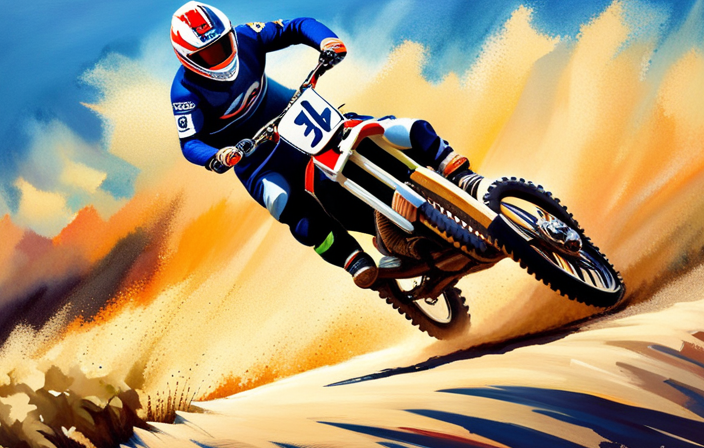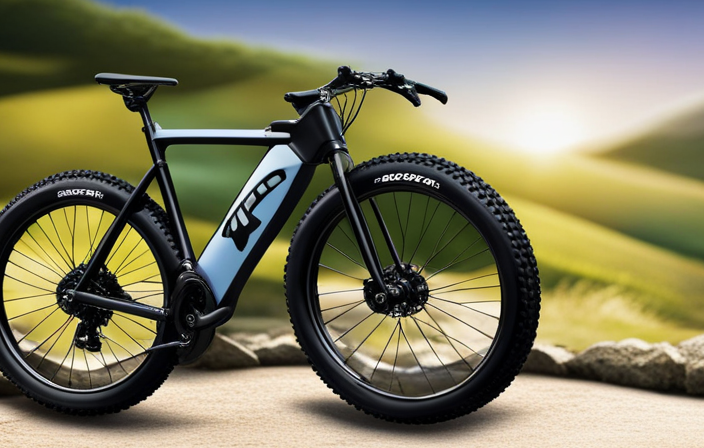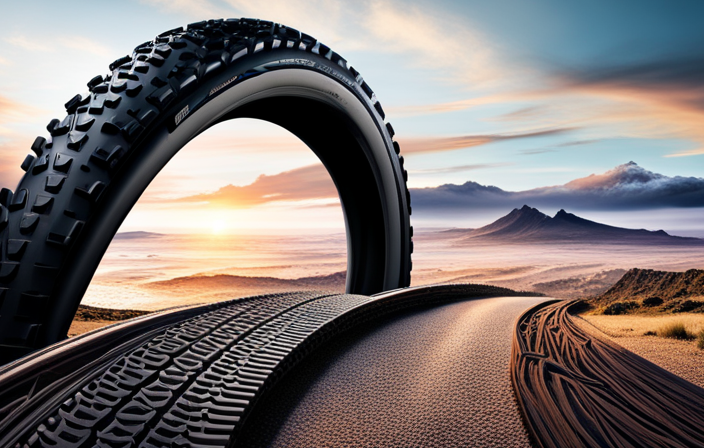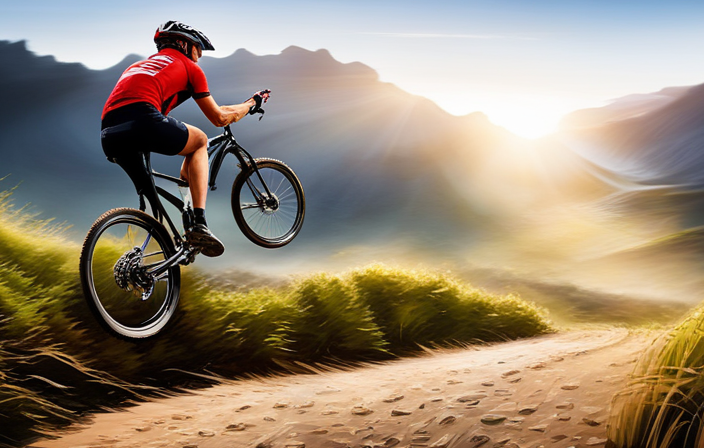Think you’re up for the challenge of riding a dirt bike on gravel? Let me tell you, my pal, it’s no walk in the park. **Gravel riding demands finesse, skill, and a thorough grasp of the terrain**. Embrace the adventure and *discover the thrill of mastering this unique riding experience*!
Lucky for you, I’ve got the inside scoop on how to conquer those loose rocks and slippery surfaces. From choosing the right bike to mastering braking techniques, I’ll guide you through every step of the way.
So buckle up (or should I say strap on your helmet?), because we’re about to embark on an off-road adventure like no other!
Key Takeaways
- Choose a bike designed for off-road use with good suspension
- Adjust your riding technique by leaning forward slightly for stability
- Maintain control and balance by looking ahead and anticipating obstacles
- Enhance safety by wearing protective gear such as helmet, goggles, gloves, and boots
Choose the Right Bike for Gravel Riding
To ride a dirt bike on gravel, it’s important to choose the right bike. When it comes to choosing the right bike for gravel riding, there are a few key factors to consider. First and foremost, you want a bike that is designed for off-road use and has good suspension. This will help absorb the bumps and vibrations that come with riding on gravel terrain.
Another important aspect to consider is the size of the bike. You want a bike that is nimble and easy to handle in order to navigate through gravel safely. Smaller bikes tend to be more maneuverable, making them ideal for this type of riding.
In addition to choosing the right bike, it’s also important to make some riding technique adjustments when riding on gravel. One such adjustment is leaning forward slightly while standing on the footpegs. This helps increase stability and control over the bike.
Getting familiar with the terrain is crucial when it comes to riding a dirt bike on gravel. By understanding how different types of gravel behave and react under your tires, you can adapt your riding style accordingly for better traction and handling.
By choosing the right bike and making necessary adjustments in your technique, you can confidently ride a dirt bike on gravel terrains. Now let’s get familiar with the terrain itself…
Get Familiar with the Terrain
First, you need to acquaint yourself with the terrain. Gravel riding can be challenging, but getting comfortable and building confidence is essential. Here are three key aspects of the terrain that you should be aware of:
-
Loose gravel: Riding on loose gravel requires a different approach than on solid ground. The bike may slide or lose traction, so it’s crucial to maintain a relaxed grip on the handlebars and stay balanced.
-
Uneven surfaces: Gravel roads often have bumps, ruts, and potholes that can make your ride bumpy and unpredictable. To navigate these obstacles smoothly, keep your knees slightly bent and let your body absorb the shocks.
-
Dust clouds: When riding in gravel, expect dust clouds to form behind you due to loose particles being kicked up by your bike’s tires. Be prepared for reduced visibility by wearing goggles or sunglasses to protect your eyes.
By familiarizing yourself with these aspects of the terrain, you will gradually get more comfortable and build confidence in riding a dirt bike on gravel.
Now that you understand the terrain better, it’s time to adjust your riding technique for optimal performance on this challenging surface without compromising safety or control.
Adjust Your Riding Technique
Now that you’ve become familiar with the terrain, it’s time to adapt your technique for optimal performance on this challenging surface. Adjusting your body posture and managing throttle control are critical elements when riding a dirt bike on gravel. By making these adjustments, you can maintain better control over your bike and navigate through the loose and unpredictable surface more effectively.
To adjust your body posture, it’s essential to stay balanced and centered on the bike. Keep your elbows up and slightly bent, allowing for quick reactions to changes in the terrain. By standing up on the footpegs, you’ll have better control over the bike’s movements. This position also helps absorb shocks from bumps and increases stability.
Managing throttle control is another key aspect of riding a dirt bike on gravel. On loose surfaces like gravel, it’s crucial to be gentle with the throttle to avoid spinning out or losing traction. Gradually apply power while keeping a steady hand on the throttle. When accelerating or decelerating, do so smoothly to prevent sudden jerks that could cause instability.
Remember, maintaining a balanced body position is crucial for riding a dirt bike on gravel successfully. By adjusting your posture and controlling throttle inputs carefully, you’ll be better equipped to handle this challenging surface with confidence and ease.
Next section: ‘Maintain a Balanced Body Position’.
Maintain a Balanced Body Position
Keep your body balanced and centered on the footpegs to maintain control while riding on gravel. Maintaining a balanced body position is crucial when navigating through challenging terrain. To achieve this, there are several body positioning techniques that can greatly enhance your riding experience.
First, distribute your weight evenly between the front and rear wheels. This will help you maintain stability and prevent the bike from sliding out in either direction. Keep your knees slightly bent and grip the bike with your lower body, allowing it to move beneath you as needed.
Next, lean forward slightly to keep more weight on the front wheel. This increases traction and improves steering responsiveness, making it easier to navigate turns and obstacles on gravel surfaces. At the same time, keep your upper body relaxed but engaged, allowing for quick adjustments if necessary.
By maintaining a balanced body position throughout your ride, you’ll not only improve control but also reduce fatigue. Riding on gravel can be physically demanding due to constant movement beneath you, so having a solid foundation is essential.
Transitioning into the next section about using proper braking techniques: As we explore how to ride a dirt bike on gravel further, it’s important to understand how using proper braking techniques can complement these body positioning techniques for an even smoother and safer ride.
Use Proper Braking Techniques
To ensure a smoother and safer ride on gravel, it’s crucial to utilize proper braking techniques while using your dirt bike. Braking on loose surfaces like gravel requires a different approach compared to riding on pavement. When it comes to braking techniques, there are two key factors to consider: weight distribution and modulation.
Firstly, maintaining the correct body position is essential for effective braking. By shifting your weight towards the back of the bike, you increase traction on the rear tire, preventing it from sliding out. This balanced body position ensures stability and control throughout the braking process.
In terms of modulation, it’s important to apply the brakes gradually rather than abruptly. Squeezing the front brake lever too hard can cause the front wheel to lock up, leading to loss of control. Instead, apply gradual pressure on both brakes simultaneously while keeping your body relaxed and in a neutral stance.
By mastering these braking techniques and combining them with proper body positioning, you’ll be able to maintain better control over your dirt bike on gravel surfaces. This will allow you to smoothly transition into controlling your speed without compromising safety or stability.
Control Your Speed
Controlling your speed is essential for a safer and smoother experience on loose surfaces like gravel. When riding a dirt bike on gravel, it’s crucial to increase control and maintain balance. Here are three key strategies to help you achieve this:
-
Gradual acceleration: Start by gently twisting the throttle to avoid any sudden jerks or loss of traction. This will allow you to maintain stability and prevent unnecessary wheel spins.
-
Smooth braking: Use both your front and rear brakes in unison, applying gradual pressure rather than slamming them on abruptly. This technique helps distribute the braking force evenly, minimizing the risk of skidding or toppling over.
-
Proper body positioning: Positioning your body correctly while riding on gravel can greatly enhance control. Keep your weight slightly forward, with your elbows bent and knees flexed, allowing you to absorb bumps and adjust quickly to changes in terrain.
By following these techniques, you’ll be able to increase control over your dirt bike while maintaining balance on gravel surfaces. Looking ahead and anticipating obstacles becomes easier when you have full command of your speed and stability.
Now let’s move onto the next section where we will discuss how to look ahead and anticipate obstacles for a safer ride.
Look Ahead and Anticipate Obstacles
Looking ahead and anticipating obstacles is crucial for a safer and smoother experience while riding on loose surfaces like gravel. When riding a dirt bike on gravel, it’s important to constantly scan the path ahead and be prepared for any potential hazards that may come your way. By maintaining focus and keeping your eyes up, you can spot obstacles such as rocks, branches, or uneven terrain before they become an issue.
To help illustrate the importance of looking ahead and anticipating obstacles, consider the following table:
| Hazard | Location | Action |
|---|---|---|
| Loose Gravel | Straightaways | Reduce speed to maintain control |
| Potholes | Corners | Adjust body position to navigate around them |
| Fallen Branches | Trails | Slow down and steer clear |
By being aware of these potential hazards in advance, you can react quickly and make necessary adjustments to avoid accidents. Anticipating what lies ahead allows you to maintain control over your bike and prevent any sudden surprises that could lead to loss of balance or traction.
With this understanding of how vital it is to anticipate obstacles, we can now transition into discussing another essential aspect of riding on loose surfaces: maintaining a firm grip on the handlebars.
Maintain a Firm Grip on the Handlebars
Make sure you keep a tight grip on the handlebars to ensure stability and control while riding on loose surfaces. Focusing on handlebar control is crucial when navigating gravel, as it allows you to maintain balance and make precise adjustments.
Here are three key aspects to consider:
-
Hand Positioning: Position your hands towards the outside of the handlebars, near the grips. This provides better leverage and control over the bike’s front end.
-
Grip Pressure: Apply firm but not excessive pressure on the handlebars. Squeezing too tightly can restrict your movement and cause fatigue, while gripping too loosely may result in loss of control.
-
Body Posture: Maintain an upright position with slightly bent elbows and relaxed shoulders. Distribute your weight evenly between the foot pegs for optimal balance and maneuverability.
Improving body posture is just as important as maintaining a firm grip on the handlebars. By keeping your upper body relaxed yet engaged, you’ll be able to absorb bumps more effectively and respond quickly to changes in terrain.
Transitioning into staying relaxed and flexible, remember that maintaining a proper grip is only one part of riding on gravel; staying calm and adaptable will also contribute to your overall performance.
Stay Relaxed and Flexible
To maintain stability and maneuverability on loose surfaces, it’s important for me to stay relaxed and flexible while riding a dirt bike on gravel. When I encounter gravelly terrain, my first instinct is often to tense up and grip the handlebars tightly. However, this can actually hinder my ability to control the bike effectively.
Instead, I remind myself to stay calm and focus on the path ahead. By keeping my body loose and flexible, I am better able to adapt to the changing conditions of the gravel surface. This allows me to make quick adjustments in my body position and weight distribution as needed.
When riding on gravel, it’s crucial not to fight against the bike or try to force it into submission. Rather, I need to work with the bike, allowing it to move beneath me while maintaining a balanced posture. By staying relaxed and flexible, I can absorb bumps and vibrations more effectively, which enhances overall control over the bike.
As I navigate through the gravel terrain with ease, gradually increasing my confidence and speed becomes natural. With every turn and twist of the throttle, I become more attuned to the unique challenges offered by riding a dirt bike on gravel.
Transitioning smoothly into the next section about gradually increasing confidence becomes an exhilarating adventure that awaits me around every bend in this exciting off-road journey.
Gradually Increase Your Confidence and Speed
As you gain more experience and become more comfortable, you’ll naturally start to build confidence and increase your speed while riding on loose surfaces.
Riding a dirt bike on gravel requires a unique set of skills, and gradually pushing your limits will help you improve both your confidence and speed.
Here are three important factors to consider as you strive to become a more proficient rider:
-
Body Position: Maintaining the correct body position is crucial when riding on gravel. Keeping your weight centered over the bike helps maintain stability and control, allowing you to navigate through uneven terrain with ease.
-
Throttle Control: Learning to modulate the throttle is essential for increasing speed on gravel. Smoothly apply power as you accelerate, avoiding abrupt or aggressive movements that could cause loss of traction.
-
Braking Technique: Mastering braking technique is vital for maintaining control while increasing speed on loose surfaces. Gradually apply both front and rear brakes together, distributing the force evenly to prevent skidding or sliding.
By focusing on these aspects of riding, you can steadily increase your confidence and improve your speed on gravel roads or trails.
As we move into the next section about practicing cornering on gravel, it’s important to remember that building these foundational skills will greatly enhance your overall riding ability without compromising safety.
Practice Cornering on Gravel
Practicing cornering on loose surfaces can greatly enhance your off-road riding skills. When riding a dirt bike on gravel, one of the most important skills to master is cornering. It requires a combination of technique and confidence to improve cornering skills and maintain stability on gravel.
To start, it’s crucial to approach corners with the right body position. Keep your elbows up and weight centered over the bike to maintain balance. As you enter the turn, lean into it while keeping your eyes focused on the exit point. This will help you anticipate any obstacles or changes in terrain.
When cornering on gravel, it’s important to be smooth with your inputs. Avoid sudden movements or jerky throttle control as this can cause loss of traction. Instead, gradually apply throttle through the turn while maintaining a steady speed.
Another key aspect of cornering on gravel is controlling your braking technique. Use both front and rear brakes simultaneously but be cautious not to lock them up, as this can lead to instability and skidding.
By practicing these techniques regularly, you’ll build confidence in navigating corners on loose surfaces and improve your overall riding skills.
Next, let’s delve into how learning to handle skids and slides can further enhance your dirt biking abilities without compromising safety.
Learn to Handle Skids and Slides
Mastering the art of handling skids and slides can greatly enhance your off-road riding skills on loose surfaces. When riding a dirt bike on gravel, it is crucial to understand the physics of skidding and how to recover from a slide. Skidding occurs when the tires lose traction with the ground, causing them to slide sideways. This can be caused by excessive speed, abrupt braking or acceleration, or improper weight distribution.
To learn to recover from a slide, it is important to remain calm and maintain control of the bike. When you feel the rear tire start to slide out, gently apply pressure on the opposite footpeg while countersteering in that direction. This will help regain traction and straighten out the bike. It may take some practice to get a feel for this technique, but once mastered, it becomes second nature.
Understanding the physics of skidding can also aid in preventing slides in the first place. By properly weighting your bike’s front end and keeping your body position balanced over the center of gravity, you can reduce the chances of losing control. Additionally, being aware of factors such as tire grip levels and surface conditions will allow you to adjust your riding style accordingly.
In conclusion, learning how to handle skids and slides is an essential skill for any dirt biker navigating gravel terrain. By mastering these techniques and understanding their underlying principles, riders can ride with confidence knowing they have control even in challenging situations.
Transitioning into our next topic about using rear brake for stability…
Use the Rear Brake for Stability
In the previous section, we discussed the importance of learning to handle skids and slides while riding a dirt bike on gravel. Now, let’s dive deeper into another crucial technique that can greatly enhance your stability on these challenging surfaces: using the rear brake.
Mastering the rear brake technique is essential for maintaining control and stability when riding on gravel. By applying gentle pressure to the rear brake lever, you can effectively slow down and stabilize your dirt bike. This technique allows you to maintain traction with the ground, preventing any sudden or aggressive movements that could lead to loss of control.
To help you visualize this technique, let’s take a look at a handy table:
| Rear Brake Technique |
|---|
| Apply gentle pressure |
| Maintain traction |
| Prevent loss of control |
By incorporating these gravel riding tips into your skill set, you’ll be well-equipped to navigate through challenging terrains with confidence and precision. Remember, it’s crucial to avoid sudden or aggressive movements when riding on gravel as they can easily throw off your balance and compromise your safety.
Now that we’ve covered how to use the rear brake for stability, let’s move on to our next topic – avoiding sudden or aggressive movements – which will further enhance your ability to ride a dirt bike on gravel safely.
Avoid Sudden or Aggressive Movements
Be cautious and avoid making sudden or aggressive movements while maneuvering on uneven surfaces. When riding a dirt bike on gravel, maintaining balance is crucial to ensure a smooth and safe ride. Here are some tips to help you avoid sudden movements and stay in control:
-
Gradual Acceleration: When starting or picking up speed, gently apply the throttle instead of abruptly twisting it. This will prevent your tires from losing traction and sliding out.
-
Smooth Braking: Use both your front and rear brakes simultaneously, but apply them gradually rather than slamming them. Sudden braking can cause your wheels to lock up, leading to loss of stability.
-
Feathering the Clutch: By slightly engaging and disengaging the clutch while decelerating, you can maintain better control over your bike’s speed without jerking motions.
-
Leaning with Precision: Shift your body weight smoothly as you navigate turns or corners. Maintain a relaxed grip on the handlebars and use subtle shifts in body position to maintain balance.
By avoiding sudden movements and practicing these techniques, you’ll be able to maintain better control over your dirt bike on gravel surfaces.
Remember that safety should always be a priority when riding off-road vehicles like dirt bikes; therefore, it’s important to wear protective gear at all times and ride responsibly.
Always Wear Protective Gear and Ride Responsibly
Make sure you always wear the appropriate protective gear and ride responsibly when maneuvering on uneven surfaces. Riding a dirt bike on gravel can be thrilling, but it also comes with risks. To ensure your safety, it is crucial to use the right riding techniques and have the necessary protective gear.
When it comes to riding techniques on gravel, there are a few key points to keep in mind. First, maintain a stable body position by standing up on the footpegs and keeping your knees slightly bent. This will give you better control over the bike and help absorb any bumps or vibrations from the rough terrain. Additionally, avoid sudden acceleration or braking as this can cause loss of traction and result in accidents. Instead, gradually increase or decrease your speed to maintain control.
Now let’s talk about protective gear. When riding on gravel, it is essential to wear a helmet that provides adequate protection for your head in case of a fall or collision. Additionally, wearing goggles will protect your eyes from dirt and debris kicked up by other riders or passing vehicles. It is also advisable to wear gloves that offer grip and protection for your hands, as well as boots that provide ankle support and have sturdy soles for better traction.
Here’s an example of how the table could look:
| Protective Gear | Purpose |
|---|---|
| Helmet | Protects head from injuries |
| Goggles | Shields eyes from dirt and debris |
| Gloves | Provides grip and hand protection |
| Boots | Offers ankle support and better traction |
By following these riding techniques and wearing the right protective gear, you’ll be able to enjoy the thrill of riding a dirt bike on gravel while minimizing potential risks. Remember to always prioritize safety when hitting those uneven surfaces!
Frequently Asked Questions
Can I ride a dirt bike on gravel without any prior experience?
No, it’s not advisable to ride a dirt bike on gravel without any prior experience. Riding techniques and choosing the right gear are crucial when riding off-road. Without proper knowledge and skills, it can be dangerous and lead to accidents.
It is important to learn the necessary riding techniques for gravel surfaces, such as maintaining balance, controlling speed, and maneuvering through loose terrain. Wearing appropriate protective gear is also essential for safety.
What is the best type of dirt bike for riding on gravel?
The best dirt bike brands for off-road riding on gravel are Honda, Yamaha, and KTM. These brands have a long-standing reputation for producing reliable and high-performance bikes.
When choosing tires for gravel riding, it is essential to look for ones with deep treads and a softer compound to provide better traction on loose surfaces. Additionally, selecting wider tires can improve stability and control while navigating through gravel terrain.
How should I adjust my riding technique when riding on gravel compared to other terrains?
When riding on gravel, I adjust my technique to maintain balance and control. It’s essential to anticipate the loose surface by reducing speed and keeping a firm grip on the handlebars.
To maintain stability, I distribute my weight towards the rear of the bike, allowing it to glide over the gravel without losing traction.
Additionally, maintaining a relaxed posture and using smooth throttle control helps me navigate through this challenging terrain with confidence.
What are some common mistakes to avoid when riding a dirt bike on gravel?
When riding on gravel, it’s crucial to be aware of common mistakes that riders often make.
One key technique is to maintain a steady throttle control, avoiding sudden bursts of speed or unnecessary braking.
Safety precautions include wearing proper protective gear and maintaining a firm grip on the handlebars.
Adjusting your riding technique for gravel involves keeping your body balanced and relaxed, while also anticipating potential hazards on the uneven surface.
Making these adjustments will help ensure a smooth and controlled ride on gravel terrain.
Are there any specific safety precautions I should take when riding a dirt bike on gravel?
When riding a dirt bike on gravel, it’s crucial to prioritize safety. Gravel riding tips include maintaining proper body positioning, keeping a firm grip on the handlebars, and staying alert for any loose gravel or obstacles.
Additionally, wearing appropriate protective gear is of utmost importance. Investing in a quality helmet, gloves, boots, and durable clothing will greatly reduce the risk of injury in case of an accident.
Remember that safety should never be compromised while enjoying the thrill of off-road riding.
Conclusion
In conclusion, riding a dirt bike on gravel can be an exhilarating experience if done correctly.
By choosing the right bike for the terrain and adjusting your riding technique, you can navigate through the gravel with ease.
Maintaining a balanced body position and using proper braking techniques will ensure stability and control.
It’s also important to learn how to handle skids and slides, using the rear brake for added stability.
Remember to avoid sudden or aggressive movements and always wear protective gear while riding responsibly.
So go out there, embrace the challenge of gravel riding, and enjoy the thrill of conquering any obstacle that comes your way!









